Australia So Much to See


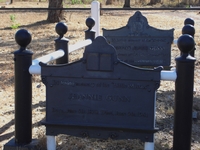
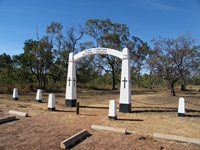
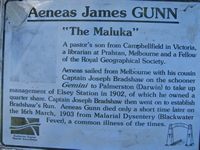
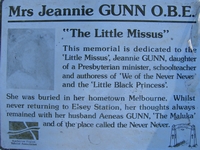
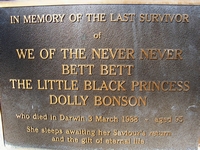
We turned off the Highway to visit the historic
Mataranka - Hot Springs in the Never Never Land
A replica of the station homestead, created for the filming of “We of the Never Never” can be seen at Mataranka Homestead.
Mrs Aeneas Gunn had also written another book, "The Little Black Princess” about a girl she called Bett Bett in the book, based on a young Aboriginal servant girl with whom she had formed a special bond with whilst at Elsey Station. Just a little of The Princess’s successful later life can be seen here on this link
No more watching the sunset over the far horizon, as we were now amongst tropical trees such as Bouhinia and the deciduous Kurrajong. Birds were abundant and their calls had the ring of a rainforest. It was beautiful, and exciting to have reached the contrast
of the wet tropics, but I also felt a real sadness at leaving the semi arid areas.
We stayed at the Mataranka Cabins and Camping; three kilometres from the small townsite along
A short walk took us to Bitter Springs, where fast flowing water comes out of the ground at 32º Celsius and rushes down a fairly narrow stream. Across the other side of this stream from the first landing are flat rocks to sit on while partially immersed in the comfortably warm blue water. Some people floated downstream with their thongs on the end if their floaty noodles so they could walk back. I swam as far as the second landing, about half way along the stream, but no further as the ground was too prickly to walk on to return and as the stream narrowed the current was very strong and would have been too difficult for a poor swimmer like me to return all the way. Even swimming back from this half way point was not easy, particularly where the channel narrowed. Every time I stopped to allow a family on noodles to pass I was washed backwards, so progress was hard and slow. Signage at Bitter Springs shows the water being discharged into the Springs at the rate of 300 litres per second and that nearby Rainbow Springs (at Mataranka Homestead) the discharge is 130 litres per second. While the latter is still a lot of water, conflicting signage at Rainbow Springs equated to around 300 litres per second also. Late afternoon each day we walked to Bitter Springs for a soak and swim in the warm waters.
At Territory Manor, another caravan park closer to the town along
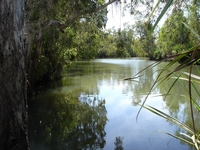
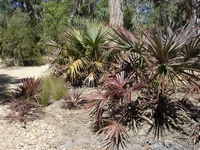
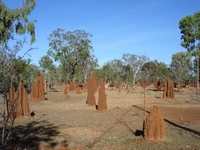
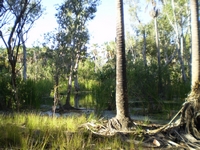
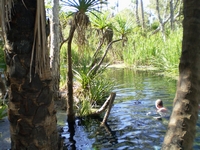
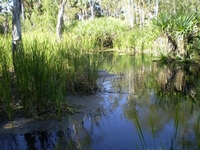
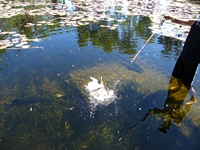
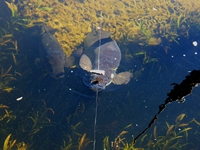
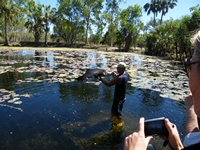
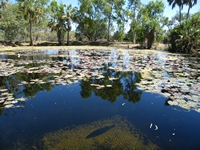
The barramundi are kept in a lovely lily covered pool at Territory Manor. Here the fish wait at the feeding platform for their
keeper
Caught – he picks one up to show the eager audience
One barramundi comes to the offered piece of fish when a rival arrives on the scene
Snap – in an instant and a flurry of foam he takes the fish before another rival closes in
Mataranka Homestead (1816) is now the centre of a resort with accommodation and a camping area. We noticed flood lines marked in the bar area which is at ground level under the homestead – almost to the ceiling in one case. The pool close by was concreted during WWII, and tourists sat as the warm shallow water flowed past them. The deep waters flowing through a natural channel at Bitter Springs is far more impressive.
On display at Mataranka Homestead Resort is a replica of the small cottage that was the station homestead where Aeneas and Jeannie
Gunn lived, as constructed for the movie made of her book, ‘We of the Never Never’.
A short walk from the homestead to the springs is on a boardwalk amongst impressive tall Mataranka palms. Beware of flying fox
droppings from above.
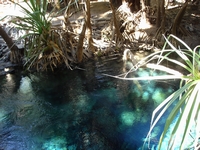
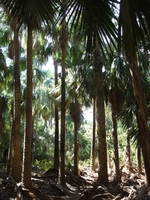
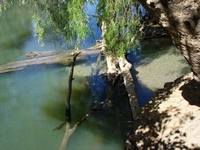
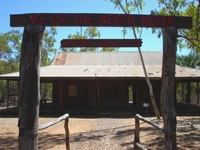
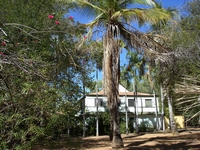
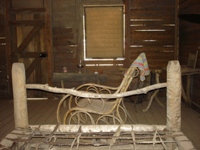
Red cabbage palms are found along the waterways around Mataranka. This ancient species is related to those found much further
south at